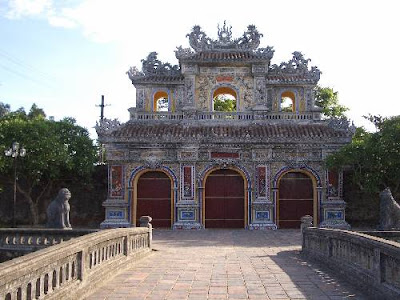The Imperial City of Hue, Vietnam’s ancient Imperial Capital, lies at the mouth of the Perfume River. It, too, has been disfigured by warfare, first by French colonists who sacked and burnt the Imperial Library as a reprisal for resistance, and then by a massive US barrage during 1968 Tet Offensive that destroyed much of Hue’s ancient Citadel. Nevertheless, the restoration work, and Hue’s status as a World Heritage Site, makes it an important destination for visitors. Hue has a small airport with regular flights from Hanoi and Ho Chi Minh City. At present, the few good hotels in Hue City are often fully-booked for most of the peak season. However, several new hotels of a higher standard are under construction, so four and five star accommodation should be easier to come by in 2004
>> Others topics: The temple of literature
The War Zone
This area saw most of the major confrontations during the American War. North of Hue is the Demilitarised Zone, or DMZ, and Quang Tri Province where much of the fighting occurred. The border between the communist North and the US-supported South was the Ben Hai River, not the ‘17th Parallel’ as is popularly believed. The area still bears the scars of the massive bombardments that took place.
The few remains of the many camps and combat bases, the barren ground pockmarked with craters, and the tens of thousands of graves in the National Cemetery, a fraction of the million North Vietnamese soldiers who died in the conflict, are solemn reminders of war. Nearby is the Vinh Moc tunnel complex, less extensive, but more authentic, than the more famous Cu Chi tunnels near Ho Chi Minh City.
>> Others topics:
Bach Ma National Park
Forty kilometres south of Hue is Bach Ma National Park, one of Vietnam’s best-managed nature reserves. The park encompasses a mountain area that was once a colonial hill-station. As well as good nature trails, waterfalls, lush vegetation and opportunities for trekking, Bach Ma has spectacular views over the coast.
Lang Co Beach
Twenty-five kilometres further south, Lang Co Beach is a long stretch of white sand with a pretty village and an attractive lagoon at the southern end. Halfway along is recently built resort hotel on the beach, a short distance from Highway 1. Its proximity to Hue makes it an alternative to accommodation in the city itself.
The Hai Van Pass
The mountains straddled by the Hai Van Pass are generally regarded as an unofficial demarcation line between the north and the south of Vietnam. It has spectacular views from its highest point, a good reason for avoiding the new tunnel cut through the granite peaks.










0 nhận xét:
Đăng nhận xét